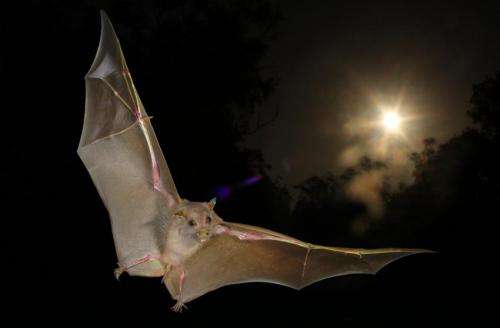'Non-echolocating' fruit bats actually do echolocate, with wing clicks

In a discovery that overturns conventional wisdom about bats, researchers reporting in the Cell Press journal Current Biology on December 4 have found that Old World fruit bats—long classified as "non-echolocating"—actually do use a rudimentary form of echolocation. Perhaps most surprisingly, the clicks they emit to produce the echoes that guide them through the darkness aren't vocalizations at all. They are instead produced by the bats' wings, although scientists don't yet know exactly how the bats do it.
"I was surprised by the fact that all of the fruit bats we recorded clicked and by the fact that clicks are produced by the wings," says Yossi Yovel of Tel Aviv University in Israel. "Arjan and I still find that hard to believe."
Yovel and postdoctoral fellow Arjan Boonman got their first hint about the fruit bats from a friendly man on a bus in Indonesia who told them about a species of bat that clicked with its wings. As further confirmation, Boonman found a single old paper about a fruit bat with wings that clicked, but it wasn't clear whether those clicks were good for anything.
Rather than look for that one earlier-described species in particular, Yovel suggested something else: "Why not check other fruit bats?"
They selected a total of 19 wild individuals representing three species of fruit bat and different parts of the evolutionary family tree to find that all of them did produce audible clicks with their wings.
"We did all we could to prove it wrong, including sealing the bats' mouths and anesthetizing their tongues, but nothing stopped them from clicking, except for when we interfered with their wing flaps," Yovel says.
Further study showed that two of the three species increased their clicking rate by a factor of three to five or even more when placed in a dark tunnel, implying that the clicks are a natural behavior for the bats.
Tests of the animals' ability to find their way in the dark showed that the fruit bats do have echolocation abilities, although they are poorer than those of other echolocating species. The fruit bats constantly crashed into thick cables, but they could readily learn to discriminate between larger objects: an acoustically reflective black board versus a similar-looking sheet of cloth. Even with large objects, however, the fruit bats didn't exactly come in for a smooth landing, suggesting that their ability is rather rudimentary in comparison to that of bats that rely on clicks produced from their larynxes.
The findings are interesting in light of earlier suggestions that echolocation may have evolved initially for bats to identify and avoid crashing into large objects such as cave walls, Boonman and Yovel say. The new discovery in fruit bats offers insight into how this sophisticated ability in other bats may have evolved over time, although it is unlikely that the laryngeal clicks of those other bats evolved directly from fruit bats' wing clicks. In fact, Yovel says, it's possible that echolocation in bats has independently evolved many times.
"When we study extant species of echolocating bats, we see a developed sensory system that has been adapted and improved over millions of years of evolution," Yovel says. "The rudimentary echolocation of the fruit bat is one example of how the first types of echolocation may have evolved."
More information: Current Biology, Boonman et al.: "Non-echolocating fruit bats produce bio-sonar clicks with their wings" www.cell.com/current-biology/a … 0960-9822(14)01425-0
Journal information: Current Biology
Provided by Cell Press




















